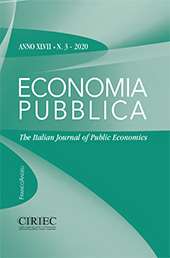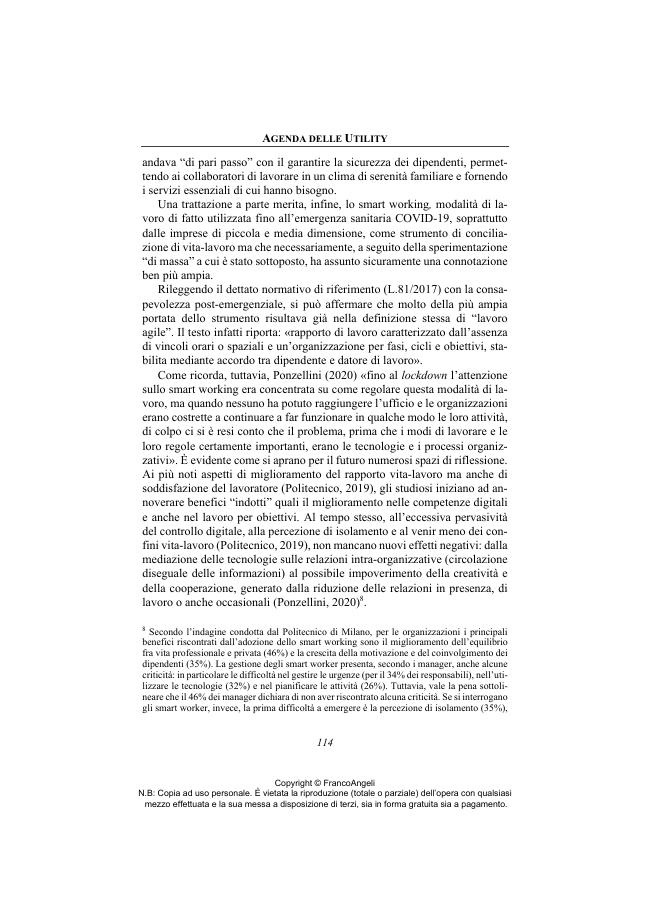2020 - Franco Angeli
Articolo
Versione Digitale
Download | Copia/incolla | Stampa
Il welfare aziendale come comunità d'impresa
103-124 p.
- L'articolo si propone di analizzare gli attuali strumenti di welfare aziendale e le azioni introdotte dai diversi livelli di regolazione. Grazie al contributo di indagini e studi di settore, vengono pertanto presentate le diverse accezioni di welfare aziendale: il cosiddetto secondo welfare, gli elementi di conciliazione vita-lavoro, i beni e i servizi che attengono più alla cultura aziendale (fringe o flexible benefit) e infine gli strumenti più innovativi e che si identi-ficano con un concetto di welfare più recente (welfare allargato alla comunità esterna). Rispetto al ruolo della contrattazione, gli autori osservano come l'attenzione delle parti sociali verso il tema sia cresciuta negli ultimi anni e come le iniziative aziendali abbiano assunto un carattere integrativo di rilievo rispetto al ruolo degli istituti negoziali collettivi.
- Il lavoro esplora, infine, le prospettive future del welfare aziendale, con uno sguardo al settore delle public utility, anche alla luce della recente emergenza sanitaria. La diffusione del COVID-19 ha infatti permesso di "accelerare forzatamente" l'adozione di strumenti già presenti nel ventaglio delle politiche di welfare aziendale ma precedentemente relegati a quote minoritarie di imprese (come il welfare allargato e lo smart working). Sarà necessario mantenere viva la raccolta delle informazioni e i primi dati rivelano come il welfare aziendale stia assumendo un ruolo di propulsore al cambiamento e possa, in futuro, costituire uno strumento capace di disegnare un nuovo modo di lavorare e di essere parte di una comunità d'impresa. [Testo dell'editore].
- This article aims to analyse corporate welfare diffusion and tools introduced by the different levels of regulation Through the contributions of surveys and sector studies, this paper presents the various meanings of corporate welfare: the so-called second welfare, welfare as work-life balance, fringe or flexible benefit and at last the more recent concept of welfare extended to the external community Exploring levels of regulation, the authors highlight how the attention of the social partners towards the welfare issue has recently grown and how company regulation's tools are supporting effectively the more traditional instruments i-troduced at the national levelFurthermore, this paper explores the prospects of corporate welfare, with a specific analysis focusing on public utilities, also taking into consideration the recent health emergency.
- The spread of COVID-19 has also made possible to speed up the implementation of tools, which were already present in the range of corporate welfare policies, previously relegated to minority business share (such as extended welfare and smart working). It is important to keep on collecting data on the issue and preliminary results suggest how corporate welfare is boosting changes in organisations and it might represent a tool capable of designing a new way of working and being part of a community in the future. [Publisher's text].
Fa parte di
Economia pubblica : XLVII, 3, 2020-
Informazioni
Codice DOI: 10.3280/EP2020-003005
ISSN: 1972-5566
PAROLE CHIAVE
- Welfare aziendale, smart working, società partecipate
- Corporate welfare, smart working, public utility
-
Nello stesso fascicolo
- Da 8.000 a 1.000? : razionalizzazione e governance delle società pubbliche
- La regolazione delle partecipate pubbliche tra disposizioni di finanza pubblica e necessità industriali
- Le reti di imprese nella gestione dei servizi pubblici locali : verso nuove forme organizzative di collaborazione tra società pubbliche
- Il controllo analogo quale presupposto dell'in house providing
- Il welfare aziendale come comunità d'impresa



